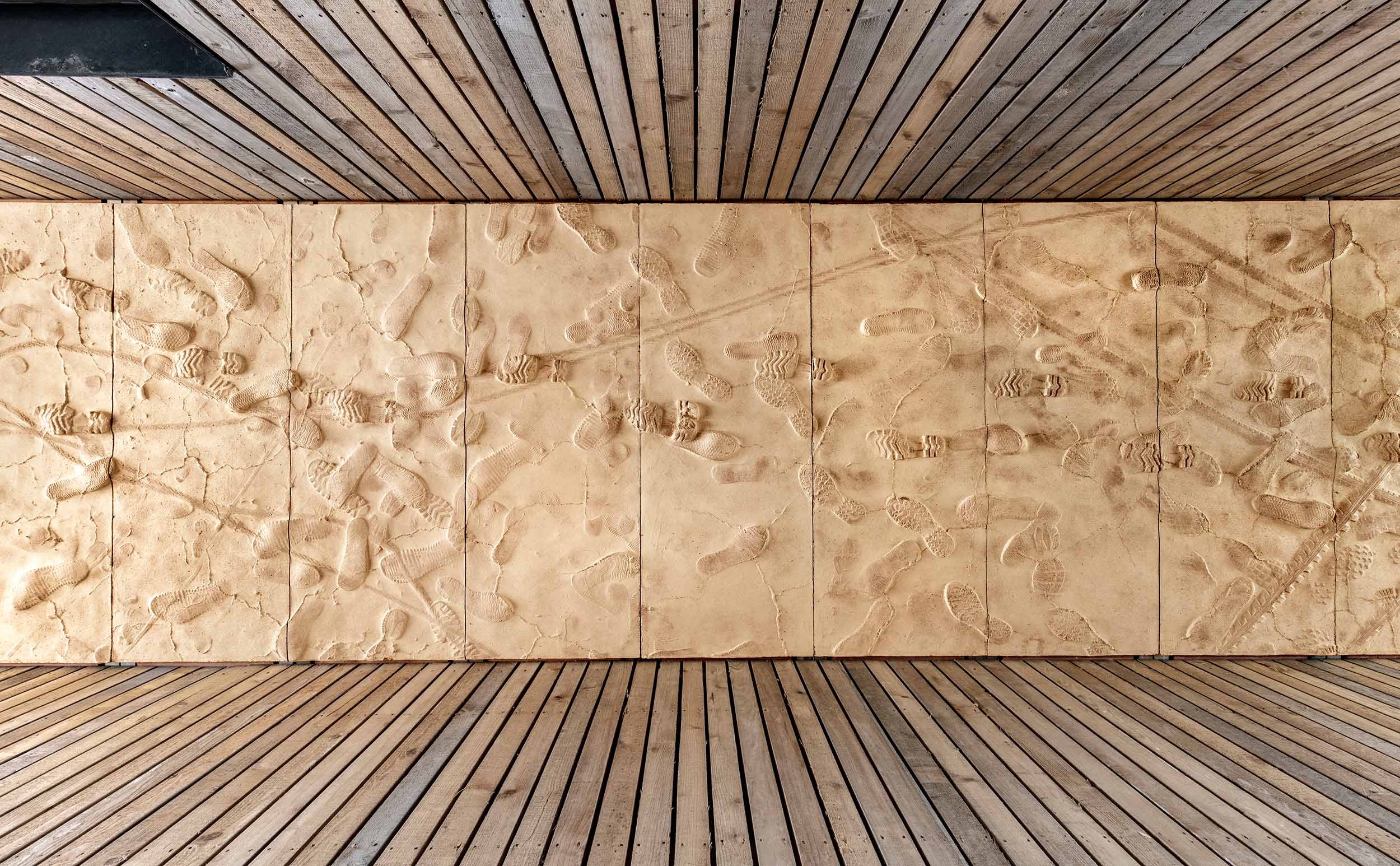In this interview I draw a line in the soft clay of Aarhus’s soil and invite Wada to talk about sources of inspiration, methods and the common thread in her art.
Sara Staunsager (SS): What is your mission as an artist?
Mariko Wada (MW): Above all, I am a ceramicist – sometimes I describe myself as a ceramic artist.
My main purpose is to work with clay and use my hands, because that is my way of experiencing and understanding the world. The process helps me better understand and experience the world.
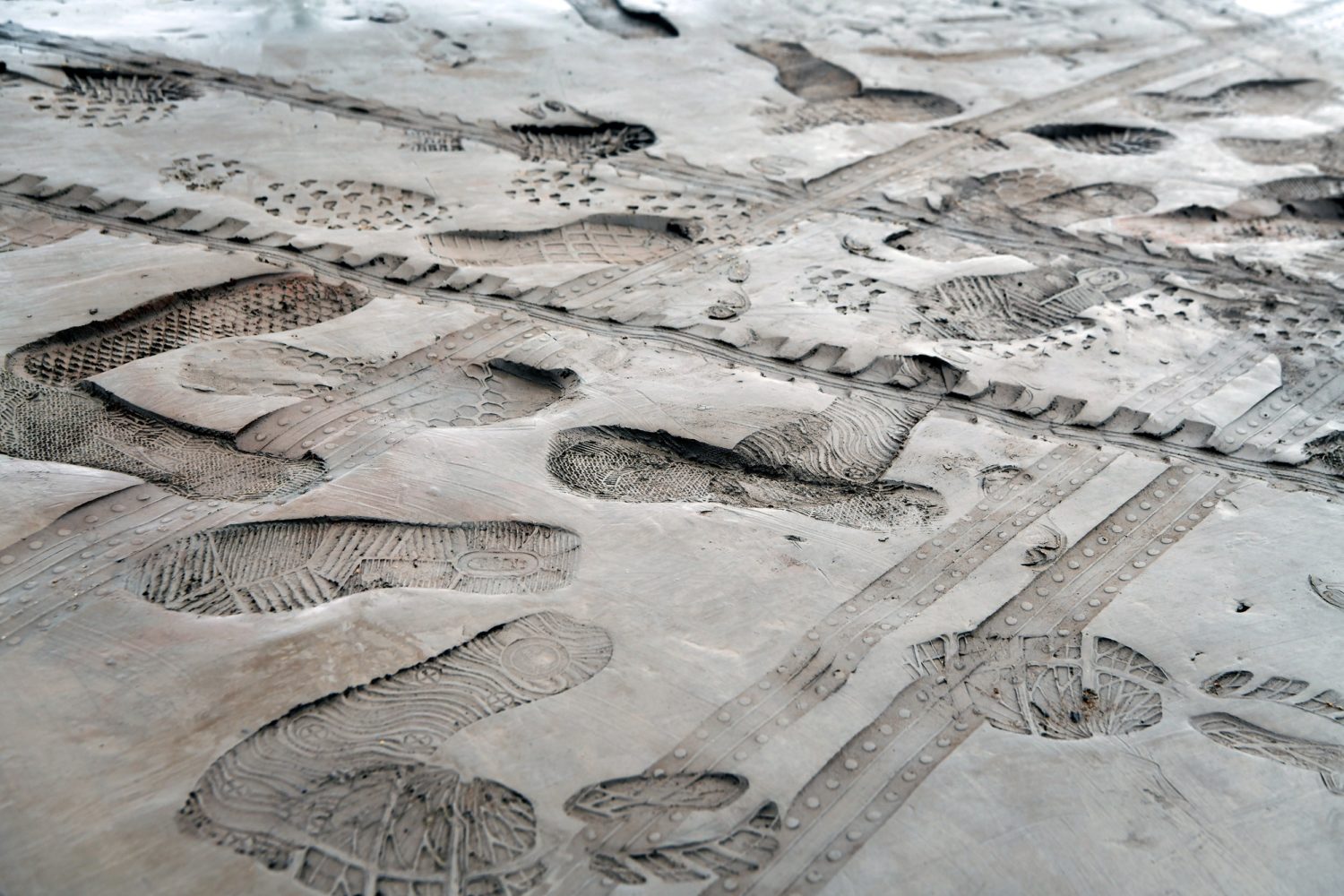
Terrain – a user-involving project
With our heads tilted back, we take in imprints of car, bicycle and pram tyres and footprints from people of all ages.Terrain measures 1.6 m x 9.0 m and consists of 15 connected sections. It is a ceramic relief, where local residents in Nye have moved through an area of soft clay soil in order to leave a personal imprint.
The diverse traces are imprints of imprints – meaning that they were cast in a negative mould to produce substantive traces with a clear presence. The relief is cast in dyed ceramic concrete finished with clay collected in Nye.
Terrain is Wada’s first art project in the public space, created for the new town of Nye north of Aarhus, which is being built on undeveloped land with a projected capacity of up to 10,000 dwellings. The relief was created in a lengthy explorative process, in which Wada became part of Nye and invited many of the newcomers to be part of her art project.
MW: Witnessing the development of the town from the beginning, I felt it would be meaningful if the art that was created for Nye were to reflect its development process, with the arrival of the first inhabitants, while also building on the historical layers of the site in order to form a connection between past, present and future.

It is late afternoon, and we sense the influence of the failing light, as the relief is deliberately not illuminated. Terrainonly draws attention to itself when it is sought. This reflects the artist’s worldview and an artistic practice driven by exploration, reflections and general uncertainty.

MW: I’m not a loud type. Maybe some of my art has the same personality – it also does not shout, but to some people it means something.
With Terrain Wada wanted to touch the very first inhabitants in the new urban development as well as future generations. She wanted to create a work of art where she, as the artist, stepped into the background and invited the new inhabitants in as co-creators. Making Terrain part of the social and cultural context that gradually takes shape in the new town and creating something that will be recognizable to the residents and which has local roots.
MW: It felt meaningful to include the inhabitants in order to give them ownership. Also, this was a brand-new town, built from scratch on undeveloped land. We are starting a new life here – I felt that all the inhabitants had something in common. They were committed to community. As a new chapter for them and for me, as a ceramicist.
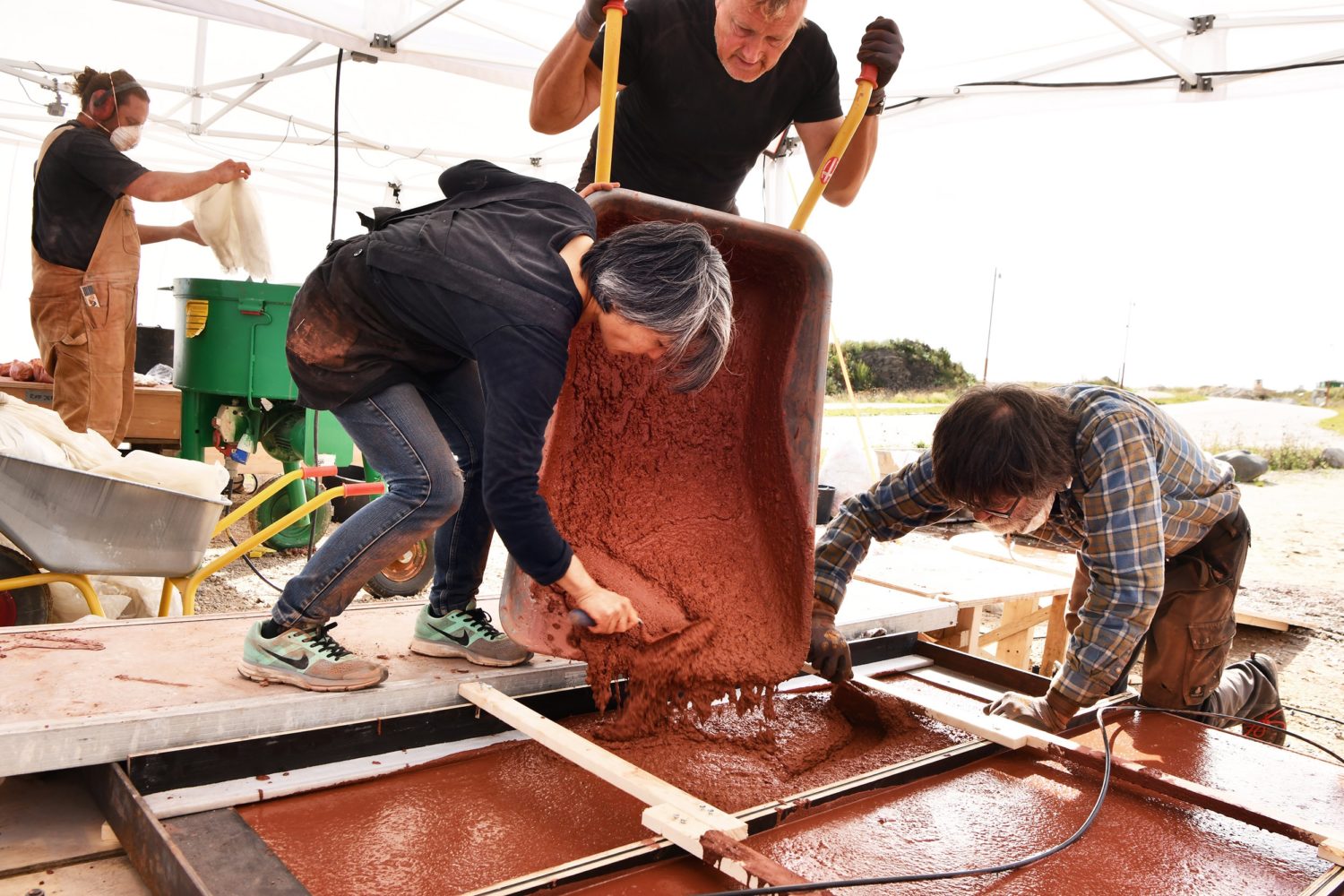
Sources of inspiration
SS: Who are your heroes in the world of art?
MW: I really like the Japanese artist Tadashi Kawamata (1953). He makes installations and builds stuff – he fills out the urban space. When Japan was hit by flooding in 2011, he actively used the natural disaster to create the installation ’Under the Water’, where he uses large amounts of construction materials, doors, furniture and other things – physically placed above us, so that we can sense how tings are floating on the water’s surface. Without words, he makes his intention clear.
Tadashi Kawamata’s installation Under the Water (2012) inspired Wada’s Terrain. Placed above ground level, Terrain is simultaneously below ground, as the imprints push out to become heavy footsteps and tyre tracks above us – because we pass underneath the relief. Wada uses the materials to create a new context that gives us a new experience and sensation of reality.
Methods
Like many others, Wada is fascinated with clay as a material. It lets her explore and create impressions on a variety of scales.
MW: The clay responds to your treatment of it. Still, it is challenging to control. It’s difficult to force the material – you always have to engage and work with the clay. In a sense, the process is a collaboration with the material. Like signs that can decode – I aim to capture and use that to create impressions, experiences and inspiration.
You could say that my task is to discover what is possible. I don’t have a specific idea, just a direction, so I arrive at the result as I go along – it’s a process for me. I strive to remain open to all possibilities. The result usually turns out much better when I draw on the inherent properties of the clay.
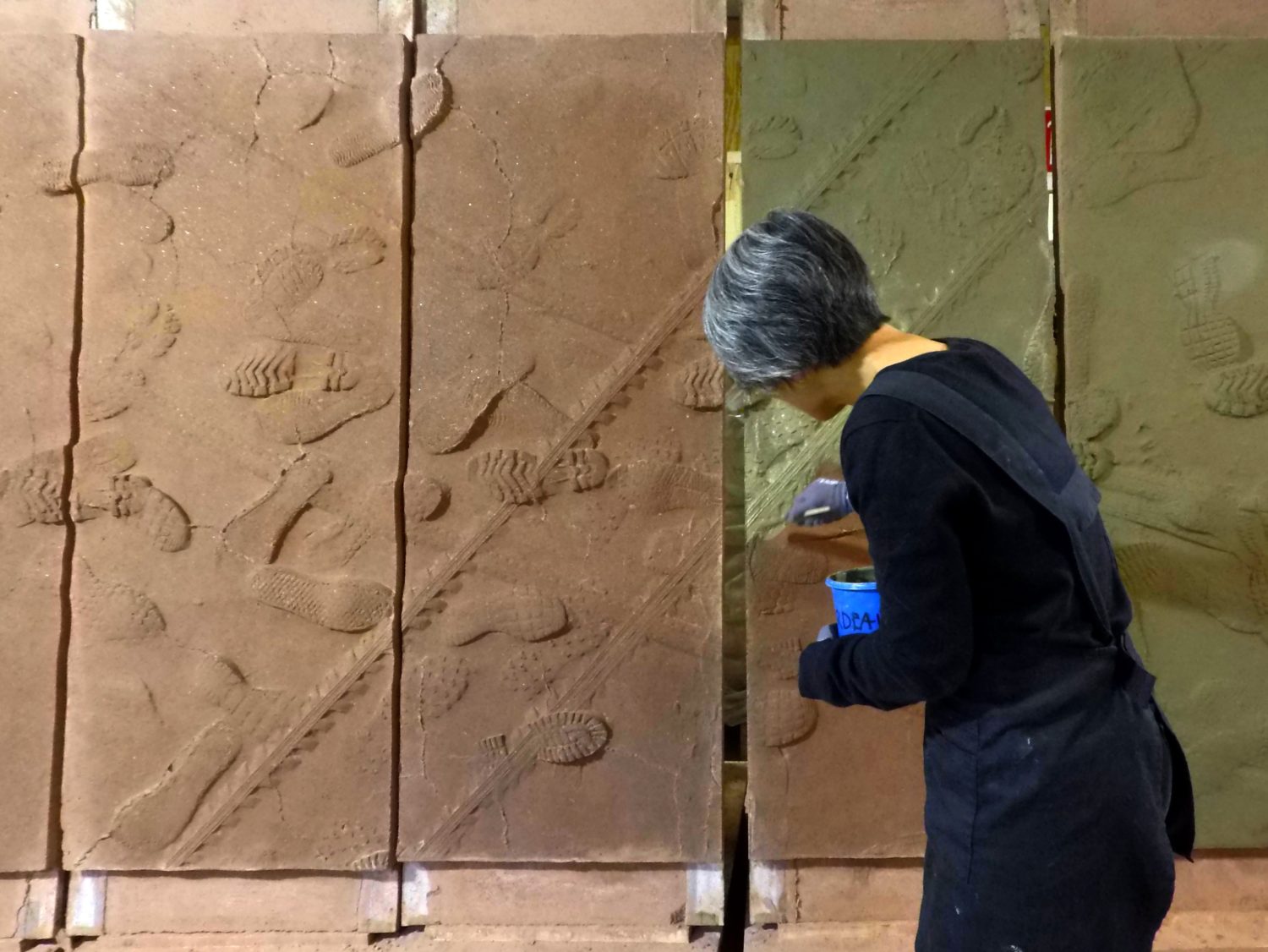
SS: How do you know when a piece is done?
MW: Some times I can see it right away – it happens naturally. However, practical issues also play in, for example if the clay is too dry for me to continue working. Like all other materials, clay has possibilities and limitations. It’s always a matter of choices, and the field of possibilities continually shrinks. You always hope that you have chosen the best options during the process, and then, at some point, there are no more decisions to be made.
SS: Are you surprised by the results?
MW: It is a lengthy development process – it unfolds step by step. When I think back, the work is very different from start to finish.
The popular Japanese author Haruki Murakami has said about his work that he writes his novels with a deliberate strategy of not knowing ahead of time how they will develop. If he knew, he would not need to write them. I feel the same way, to some extent. It would make no sense for me to create my ceramics if I knew the outcome ahead of time.
I really enjoy working with my hands and the clay. Ceramic is an exciting and fascinating universe – and I achieve a unique satisfaction from demonstrating what a skilled craftsperson can accomplish.
SS: Are you a craftsperson or an artist?
MW: I am both. Perhaps that is where my Japanese background comes into play – in my insistence on the importance of craftsmanship in my work. I think that is what makes it possible for me to create my unique artistic expression.
The common thread
SS: Is there a unifying theme to your art?
MW: My works point in different directions and depend on context. This makes it difficult to identify them as being by the same artist. The recurrent theme in all my works is the explorative process – how I have arrived at the result. Thus, I do see a common thread.
Wada’s art is currently on display in the group exhibition Open & Closed at The Future Perfect Gallery in New York in a joint project with the Danish Arts Foundation. The exhibition also features the Danish artists Annelie Grimwalde Olofsson, Cathrine Raben Davidsen, Elly Glossop, Iben Høj, Ida Elke Kallehave, Louise Hedegaard Madsen, Pettersen & Hein and Stine Mikkelsen.
About Mariko Wada
Mariko Wada has a Japanese background and has lived in Aarhus since 1998. She holds a degree in Aesthetics and Art Theory from Doshisha University in Kyoto, Japan, from 1995 and completed her education in ceramics at Design School Kolding in 2006. She has received awards both in Denmark and abroad; most recently, she was awarded the Danish Arts Foundation’s three-year working grant. Her works have been purchased by several art associations and municipalities, and the Danish Arts Foundation has ensured that her work is represented in museums. Wada is a member of the artist groups Versus and Guirlanden (The Festoon), which exhibit in Danish museums. With exhibitions in Norway, Finland, Germany, Switzerland, Belgium, France, Italy, Spain, China, Taiwan, South Korea and the United States, she represents Danish ceramics at an international level.
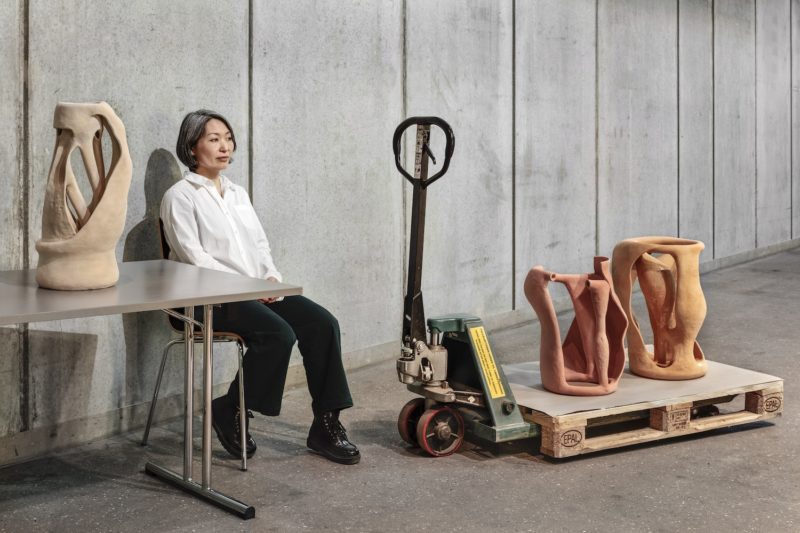
Mariko Wada, The Biennale for Crafts & Design 2019. Photo by Dorte Krogh
From the Archive
The universal language of clay by Tinne Delfs
Kunstuff 3/2009
Farewell to an outdated concept of decoration by Kristian Berg Nielsen
Dansk Kunsthåndværk 1/1999
Theme: Atmosphere – crafts and design in the public

This autumn, Formkraft will focus on the atmosphere that material culture, technology and aesthetics can add to the public space. And why it is more relevant than ever to include craft makers and designers when state-owned buildings are renovated, when municipalities develop decorative projects and when private actors seek to imbue the modern city with soul and sensuous qualities.
Articles, interviews and reviews are published regularly in October – November – December. Also remember to search for the topic in the archive.

